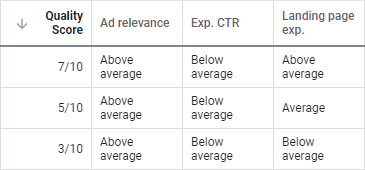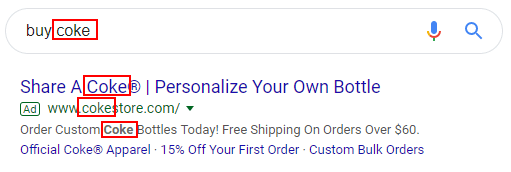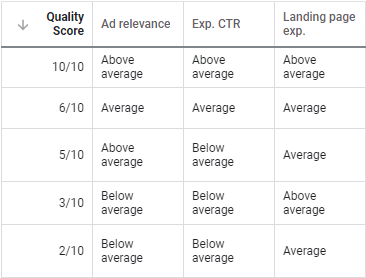Within Google Ads, every keyword is subject to Google’s “Quality Score” metric, from 1/10 to 10/10. This metric affects how much a click actually costs and whether or not an ad will actually show for a given keyword.
Quality scores are presented as a factor of three different parts: ad relevance, expected CTR, and landing page experience. Having a higher score in two of the three metrics can make up for a low score in the third metric, especially if that metric is difficult to raise.

If your quality scores are low, there will always be something to tweak.
Here are 5 simple steps you can take to improve under-performing quality scores.
1. Address ad relevance by checking if your keywords are prominently featured in ad copy.

Every ad in the ad group should contain the group’s keyword(s) in either the first headline, second headline or first description. Without this, there’s a higher chance of a low quality score.
This is why recent best practices for campaign structure recommend grouping a few very similar keywords into each ad group: the copy can be directly tailored to the keywords and intent behind them.
This means that advertisers may need to further segment existing ad groups, then include keywords in each ad.
Pro tips:
- Don’t use each keyword more than twice per ad.
- Using natural-sounding language is more important than keyword density.
- Minor variations of the keyword are acceptable.
- Try using keyword insertion in headlines.
 If your target keyword is a copyrighted term which the advertiser does not own, then it can’t be used in your ad, but you can still bid on it (if you are not sure, check with your attorney!). For example, bidding on the names of competitors typically means the exact search keywords can’t be featured. In this case, focus on the other two components of quality score.
If your target keyword is a copyrighted term which the advertiser does not own, then it can’t be used in your ad, but you can still bid on it (if you are not sure, check with your attorney!). For example, bidding on the names of competitors typically means the exact search keywords can’t be featured. In this case, focus on the other two components of quality score.
2. Review negative keyword sculpting.
Ad relevance is low when the query does not directly relate to the ad copy – but this is often a result of insufficiently targeted keywords or a negative keyword list that isn’t robust enough.
Because many keywords can be used in multiple contexts, make sure to continually review your search terms report and add new negative keywords to ensure that ads only appear for the correct search intent.
Be discriminating with negative keywords; don’t add them without checking if the term has converted in the past.
3. Address expected CTR by improving ad text and CTAs.

Provide a message that entices your audience to explore further.
Part of Google’s quality score calculation involves “expected CTR”. For advertisers, just focusing on improving actual CTR can make a big impact on quality score.
What makes people click on ads? Try adding enticing benefits, calls to action, or disclaimers.
Our clients have seen success through promising free evaluations, product promotions, or reassuring the customer that there is “no download required”.
If CTAs already exist, try making them more evocative and actionable. For example, if you’re a travel company, instead of having an ad that says “see our locations”, you could test “plan your getaway today” or “find your dream vacation spot”. A/B testing is a great way to discover what will actually get more people to click on your ads.
You can also ask yourself which selling point will best resonate with each ad group’s audience. Use the search terms report and demographic information to understand who is searching for which keywords, and match that group’s priorities to your highlighted information.
4. Address landing page experience by matching ad promise to landing page content.

“Didn’t the sign outside say ‘Steakhouse’?”
Ads should always lead the user to expect exactly what the landing page contains. CTAs should match the page contents; if the ad suggests that a user “download the free ebook” but the landing page is the website’s homepage instead of a gated download, the user will leave.
Think of the ad and landing page as statements in a conversation. The first needs to logically lead to the second in order to keep the audience’s attention.
High bounce rates can also decrease quality score. When you pay to bring someone to your site and they immediately leave, you end up wasting money that could be used for someone actually interested in your brand.
5. Ensure a quality landing page user experience regardless of ad promise.

“Okay, but I’m just looking for a bathroom…”
Preventing bounces is also a function of user experience (UX). Since this is often within the control of someone other than the individual advertiser, it can be difficult to improve on.
However, UX makes a huge difference in both conversion rates and preventing quality score loss.
UX is its own complex field, but the basics are straightforward.
Include only relevant information (e.g. page title, images of the product, or a lead generation form) on the top of the page, so the user doesn’t have to scroll down to find what’s important.
Clearly label all navigation options, but don’t overload the user – keep it simple.
Avoid unusual page structure; stick with a straightforward single- or double-column page that doesn’t distract from your message.
Use an evocative CTA to keep users engaged and usher them to take the desired action.

Quality score is one piece of the great puzzle that is a well-structured paid media campaign. Taking full advantage of the interplay between each piece requires an experienced team. Contact us for a free competitive evaluation to see if a partnership would be right for you.

